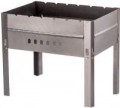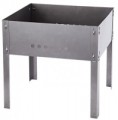Skewers capacity
The number of "seats" for individual skewers provided in the design.
This parameter is indicated only for those models that have characteristic recesses for placing skewers; if there are no such recesses, then the actual capacity will directly depend on the dimensions of the working surface (see below). As for the specific quantity, two options are most popular nowadays — for
6 – 7 skewers and for
10 skewers or more : the first option is optimal for a family picnic or a small company, the second will be useful at large events and in professional use. Products for
8-9 skewers are relatively rare, and miniature models for
5 seats or less are even rarer.
In box
—
Case. The cover makes transportation more convenient: it protects the structure from unwanted contact with surrounding objects (and, accordingly, dirt and damage — especially these objects), and also allows you to keep all removable parts together, reducing the risk of loss. Of course, for any model, you can make an impromptu case, but this is associated with certain troubles; besides, complete is usually more convenient.
Wall thickness
The thickness of the furnace walls.
This parameter is relevant primarily for solid fuel models (see “Fuel (source)”), and its general meaning directly depends on the type of product (see above), more precisely, on the material of the furnace. So, for barbecues, charcoal grills and other devices with metal fireboxes, the overall reliability and durability of the structure depends primarily on the wall thickness. At the same time, a value of up to 1 mm is considered very limited; it can be found mainly in low-cost models designed for occasional use. 1 – 2 mm can be called an average, and a thickness of 3 mm or more is already suitable for intensive daily use.
In turn, in ceramic grills and tandoors, the wall thickness is already measured in tens of millimetres; in the first case, it is usually about 18 – 20 mm, in the second — from 50 mm and more. Both there and there, thick walls serve to effectively accumulate and retain heat; accordingly, the greater the thickness, the better the product handles with these tasks.
Anyway, note that thicker (and, accordingly, more reliable and efficient) walls inevitably turn out to be heavier and more expensive.
Height
Product height in working position.
If there is no cover or canopy in the design or delivery set (see “Functions and Capabilities”), then the total height, usually, corresponds to the height of the grate, seats for skewers or other work surface. If there is a cover or canopy, then the height is given according to the overall size of the structure, and it usually does not correspond to the actual height of the working surface; the latter should be specified according to the manufacturer's documentation. However, when it comes to the lid, this difference is usually not particularly critical; but the canopy is usually located at a considerable height (comparable to the height of a person, or even noticeably greater).
In general, a height of
50 cm or less is considered relatively small,
50 – 100 cm — medium,
more than 100 cm — significant. However, when choosing a particular product, it is worth considering both the nuances described above and other features. For example, if you are looking for a portable brazier for hiking "forays" into nature, it makes sense to pay attention to low and, accordingly, light and compact models. And for professional use, when you have to “stand over cooking” often and for a long time, higher models are better suited, which you don’t have to bend over to check readiness, turn skewers, etc.
Dimensions (WxD)
Dimensions of the product deployed to the working position, in length and width; for round models, both of these dimensions are also indicated, just in such cases they are usually the same (equal to the diameter).
The general meaning of this characteristic is as follows: a larger product (with the same shape and type) usually has a larger capacity, but it turns out to be more bulky (including when folded, if such a possibility is provided), heavy and expensive. Moreover, in many cases, the overall dimensions in length and width correspond to the size of the working surface; a classic example is the traditional rectangular brazier, as well as many barbecue grills of the same shape. So if the data on the working surface (see below) are not separately indicated in the characteristics, then it may well be that the size of the brazier is equal to the overall dimensions (or differs very slightly from them). For a full guarantee in such cases, you should pay attention to the photographs of the product: if there are no shelves or other similar elements in the design that affect the length and width, then these dimensions can be used to estimate the dimensions of the working surface (that is, the total capacity and other related nuances ). For example, in the case of a traditional brazier, the width of the firebox determines the minimum length of the skewer (the skewer should be slightly longer to cover the firebox when installed across); and the number of places for skewers...directly depends on the length of the barbecue (ideally, there should be at least 60 mm between these places). If the dimensions of the working surface are given in the characteristics, then it is worth evaluating the practical capabilities of the product according to these dimensions; the overall dimensions in such cases only allow us to estimate the amount of space occupied by this model.
Also note that the height of the structure in the characteristics is indicated separately — in this case it has a different meaning than the length and width.
Weight
The total weight of the product, taking into account the main elements of equipment (lids, canopy, food stands, etc.), but excluding fuel.
It is worth evaluating this indicator taking into account the type of device. So, the most compact barbecues and barbecue grills can weigh
4-6 kg or even
less(in camping barbecues, the weight does not exceed these values at all);
7 – 10 kg for such models is considered an average, and larger values \u200b\u200bare typical mainly for large stationary structures of high capacity. But ceramic grills and tandoors are, by definition, massive: in the first case, even in the lightest models, the weight
exceeds 10 kg, in the second it is usually
more than 50 kg.
Anyway, note that both small and significant weight have their advantages. So, with similar functionality, a lighter device will be more convenient to transport, but this convenience will have to be paid for by reducing the height (which affects convenience), reducing the capacity and/or thinner walls of the furnace (which reduces reliability for metal walls, worsens for ceramic ones). efficiency). Conversely, a heavier structure will be more reliable, durable, often more spacious, but at the same time less convenient when moving from place to place, and often more cumbersome.

